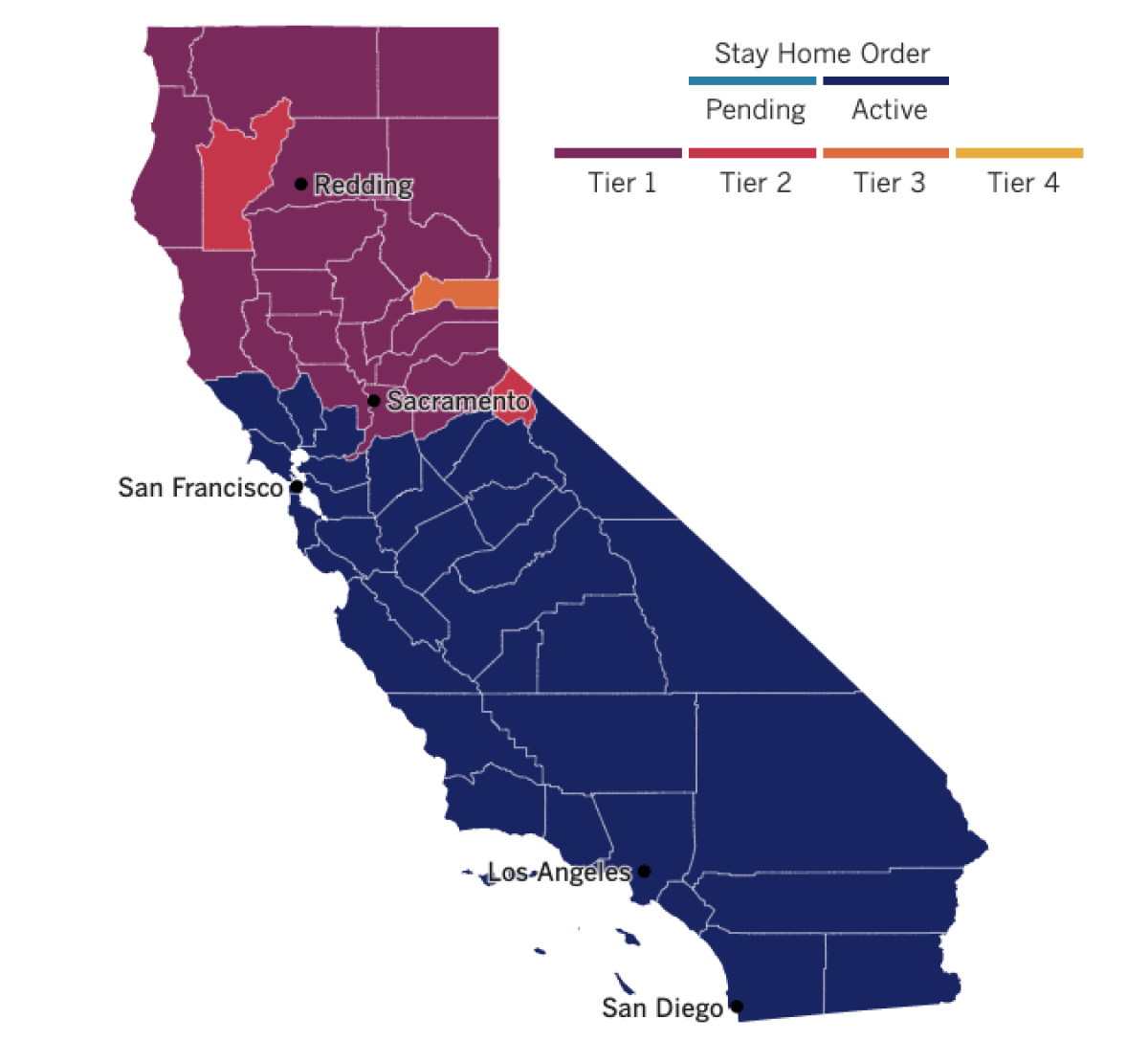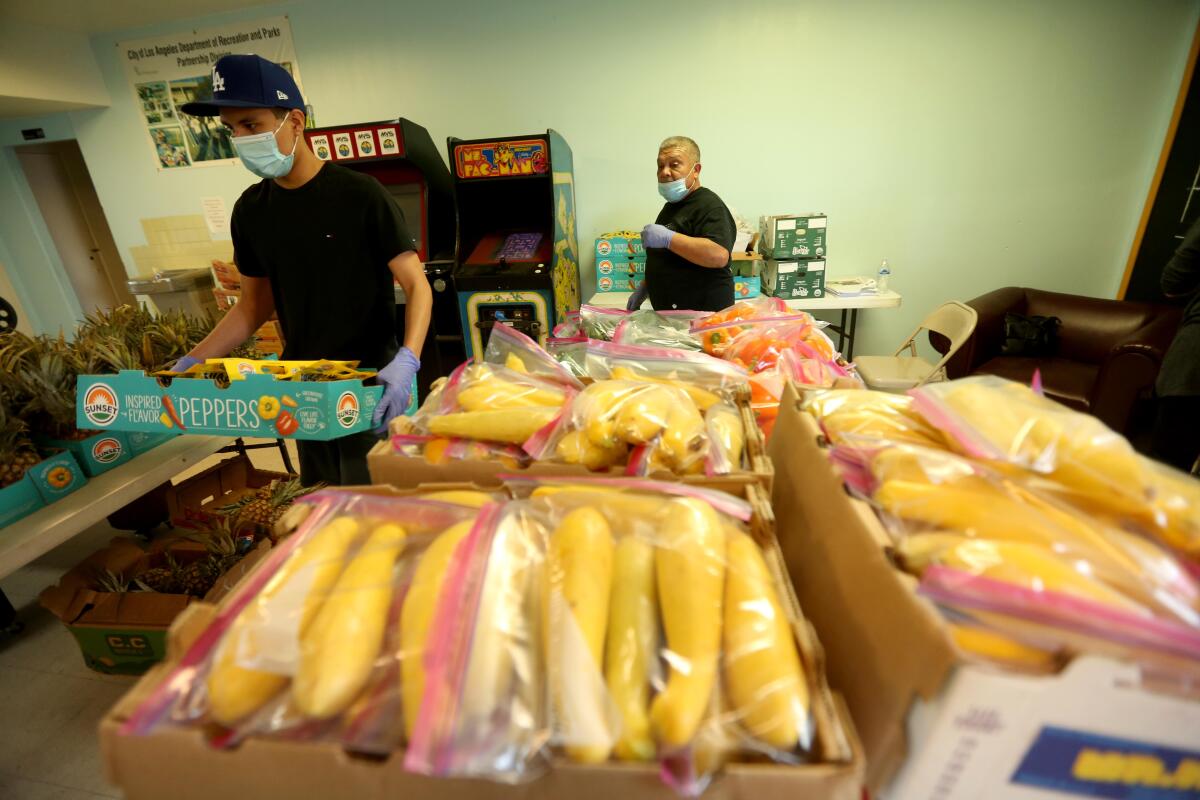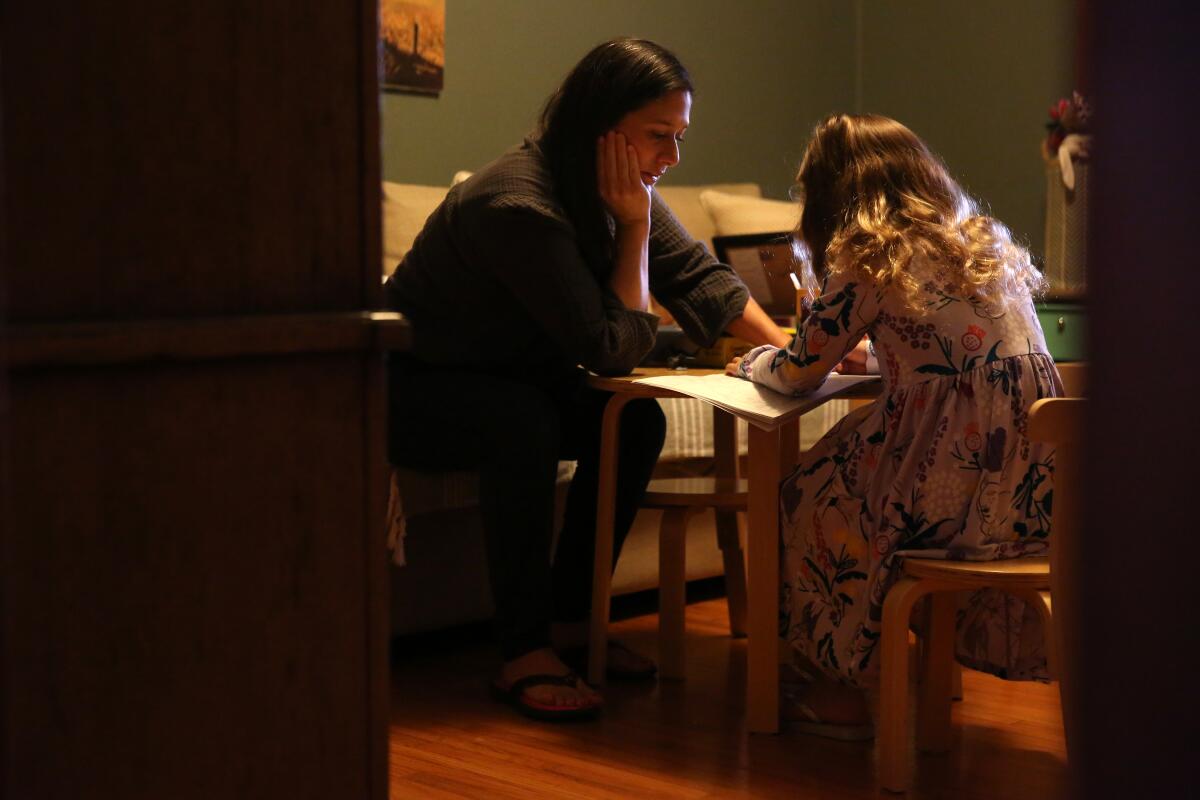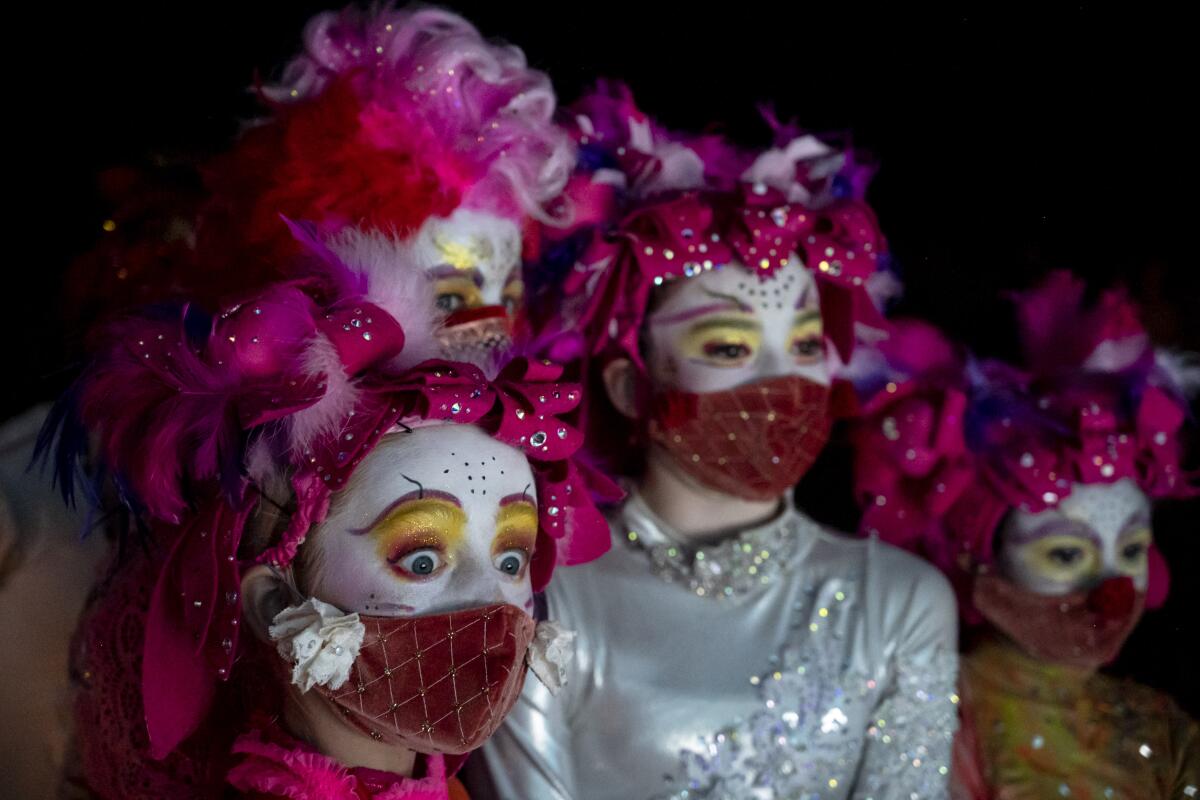Coronavirus Today: A victim of our early success
- Share via
Good evening. I’m Amina Khan, and it’s Friday, Jan. 22. Here’s the latest on what’s happening with the coronavirus, plus ways to spend your weekend and a look at some of the week’s best stories.
As we move toward what many hope will be a better path through the pandemic, it’s worth looking back to ask: How did California, which seemed to be doing so well in the outbreak’s early days, stray so far off course?
While COVID-19 had New York grappling with a mind-numbing human disaster in the spring, the Golden State was so effectively keeping the coronavirus at bay that one expert called it the “California miracle.”
Fast-forward to November, when the virus’ furious spread turned the state into the epicenter of the pandemic.
“This is a different kind of moment, a new level of danger,” Los Angeles Mayor Eric Garcetti warned ahead of the Thanksgiving holiday.
By Christmas, so many patients were struggling to breathe that hospitals were running low on oxygen. Emergency rooms in broad swaths of the state were closing their doors to ambulances, and hospital staff were forced to stuff patients into gift shops and corridors. The holiday surge has so far killed more than 18,100 Californians, more than doubling the state’s total death toll in less than three months.
Now, as the crisis shows some signs of letting up, it’s becoming clear that much of the blame falls on a false confidence that the pandemic could be contained. For the public, that complacency manifested as fatigue and frustration over safety restrictions. For health officials, it showed up in the ways they were caught off-guard by how quickly and how broadly the virus spread once the numbers began their steady — then accelerating — ascent.
“We never, never planned for something like this to happen,” said California Health and Human Services Secretary Dr. Mark Ghaly. The state’s mask mandates, business closures and stay-at-home orders “were all designed to try to avoid this.”
My colleagues Soumya Karlamangla and Rong-Gong Lin II spoke with a bevy of experts to piece together how California went from shining example to cautionary tale. You should read the whole story for the fuller picture, but in many ways, it comes down to this: California was a victim of its own early success.
When state officials announced the springtime stay-at-home orders, Californians by and large seemed to comply: Restaurants were shuttered, other businesses closed, and freeways remained eerily empty even at rush hour. Case numbers remained relatively low, leading to a false sense of security that caused Californians to drop their guard even as the virus’ spread began to accelerate later in the year.
“You pay a price for your success,” said Ali Mokdad, an epidemiologist with the Institute for Health Metrics and Evaluation. “The advice should be: This is here to stay. ... This virus is so stubborn — you make a tiny little mistake, it will go after that mistake.”
As the risks no longer seemed imminent, resentment toward state and local restrictions began to grow. Some were distrustful of authorities after Gov. Gavin Newsom attended a dinner party at the French Laundry while restaurant dining was restricted in much of the state. Others were frustrated after months of unemployment, with little government assistance, or were simply fed up with living in largely self-imposed isolation. Adherence to social distancing guidelines fell, and people began gathering indoors, often without masks. Then the holiday season hit, and residents turbocharged the virus’ spread by heading to crowded shopping malls and celebrating with people from outside their households.
The results were devastating.
Though epidemiologists warned Americans of a deadly winter wave fueled by cooler weather, they didn’t expect that temperate California would become the prime example, my colleagues write: For the six-day period that ended on New Year’s Day, California had the highest per-capita COVID-19 death rate in the nation.
“Did I expect to see December and January this bad? Yes. But I expected to see it throughout the United States,” said UC Berkeley public health professor Dr. John Swartzberg. “That’s what I think the shocker has been.”
By the numbers
California cases and deaths as of 3:46 p.m. Friday:

Track the latest numbers and how they break down in California with our graphics.
See the current status of California’s reopening, county by county, with our tracker.


What to read this weekend
A wall of defiance and suspicion
In rural northern California, skepticism of the seriousness of the pandemic runs high, and health officials face a gauntlet of challenges in getting lifesaving vaccines into the arms of some 683,300 residents. It’s “a mountainous, heavily forested region where calamity — either from illness or physical trauma — can mean hours-long drives to the nearest medical facility,” my colleague Hailey Branson-Potts writes.
While some of the problems are particular to the region, many are emblematic of the issues plaguing health officials nationwide. Among the toughest tasks in these remote towns are overcoming skepticism that the virus is a serious threat, assuaging fears over the vaccines’ safety and battling open rebellion against health orders meant to ensure the public’s safety.
Take Shasta County, where some residents have compared mask mandates to Nazis forcing Jewish people to wear a yellow Star of David, and where the county health officer has been threatened repeatedly. Or Tehama County, where in one bar on karaoke night, no one wore a mask. “Why would we?” the owner said. “We’re not sick. Masks are for sick people.”
“We’re getting very frustrated here in Northern California,” said Dr. Richard Wickenheiser, Tehama County’s health officer. “We have a lot of anti-vaxxers and a lot of independent people who just feel that COVID was a hoax, that it was going to go away when the election was over. And that didn’t happen. ... The excuses just go on and on.”

A win for L.A.’s homeless residents
Here’s a little good news: L.A. County contractors are on track to complete a 232-unit homeless housing development in downtown L.A. next month, in a project authorities are calling a milestone for speed and economy. The Vignes Street development — built in less than five months on a former industrial site, at a cost of about $200,000 per bed — “will have shattered the axiom that homeless housing takes years to build and is exorbitantly expensive,” my colleague Doug Smith writes.
The development, conceived as an experiment, is a hybrid of permanent and temporary structures and will be used flexibly for both permanent housing with services and for short-term shelter — unlike traditional homeless housing projects, designed for one or the other. The two main buildings, constructed of once-used shipping containers, will have 132 units of permanent housing. A village of trailers, each divided into five units, will be for interim housing. The administrative building will house dining facilities, laundry and support services such as case management and counseling.
The project was shaped in part by the pandemic: The bulk of funding came from the federal CARES Act, which allowed the county to avoid the labyrinthine process of finding money for affordable housing. And the health emergency provided justification for exemptions from environmental review and competitive bidding.

A teen center turned food pantry
Columnist Gustavo Arellano takes us to Will Hall Park, where crowds gather outside the Wilmington Teen Center. The long lines of people and cars aren’t there for the horseshoe pits, the outdoor gym or the Ms. Pac-Man in a vintage arcade: They’re waiting for free food. For the first time since it opened in 1968, the Teen Center has had to curtail nearly all youth activities because of the pandemic and has become more of a community pantry instead.
“Lots of parents are laid off now,” said Mike Herrera, a Wilmington native who is director of the center. Herrera, 68, has held the job for four years with no salary because “I didn’t want to see this place close down. Doctors and lawyers and athletes have come from here.”
The Teen Center’s scuffed linoleum floors and weed-choked garden beds have seen better days, but supporters keep it alive in honor of Connie Calderon, its longtime director who retired in 2008. The short, tough daughter of Mexican immigrants was so respected in the working-class town that gang members declared the Teen Center neutral ground. Read more about this storied center and the remarkable people who have kept it running.

Coupledom in the time of COVID-19
Last August, my colleague Rachel Schnalzer asked readers, “Did you fall in love or become closer with your partner during the pandemic?” She received scads of personal testaments to the ways COVID-19 has shaped our most intimate relationships.
One couple took the leap and moved in together — with a grandparent. Another nearly filed for divorce, crushed by the weight of pandemic pressures. One reader found startling new love online, while another lost a loved one to COVID-19 and relied on their partner’s unconditional support during a painful time. And there’s this delightful vignette from one Charlotte Morrison:
“I dated my college boyfriend and first true love for three years before we broke up. We weren’t ready to get married and had other plans.
“Fast-forward almost 50 years. Life’s circumstances brought us back together. He came to visit me in early March, intended to be a short visit. COVID turned it into a five-month living situation instead! It certainly has brought to light the reason why we were compatible so long ago. It’s never too late!”
Please welcome to the virtual comedy stage — Mom
In her monthly online show, professional comedian Lisa Geduldig has been featuring some up-and-coming talent: her mother. Arline Geduldig, at “89 and three-quarters,” has launched a brand-new comedy career performing alongside the pros, using her walker as a desk and papering it with Post-it notes full of ideas for jokes.
Lisa flew east to visit her mother in Florida back in March and never left. The longtime host of “Kung Pao Kosher Comedy” in San Francisco, Geduldig launched the new “Lockdown Comedy” as a way to bring some normalcy back to her new abnormal life. On a whim, she asked Arline to be a special guest. “She’s just so damn funny and fearless. She is constantly making me laugh. I thought: Why not?”
Lisa said she loves helping her mother find her comedic voice. “We’re still working on punchlines,” she said. But occasionally, daughter needs to cut off mother and summon the hook, Rachel Levin writes. Read on for a sampling of Arline’s style, and to find out how you can watch (every third Tuesday evening).
An impoddible situation
If you’re a parent of young children, you’ve probably considered — or maybe are in — a pandemic “pod.” My colleague Cindy Carcamo began her search for the perfect pod mates after her 5-year-old, deprived of school and friends, grew increasingly (and understandably) frustrated with the situation — a frustration that manifested in picking fights and slamming doors. Desperate for a solution, Carcamo sought to find a family with whom they could ride out the isolation of the pandemic.
The search turned out to be far harder than she anticipated. She crossed off the list those friends who worked outside the home or whose kids went to school in person. She gingerly felt out the ones she believed were as careful as her family — but even those on her short list turned out to have complications, such as regular visits from family whose movements could not be fully accounted for.
I know things don’t look good for our heroes, but I don’t want to spoil the end for you — so read on to find out how her pod search turns out.

Your support helps us deliver the news that matters most.
What to do this weekend
Get outside. Make the most of winter weather by taking in the ocean views along the 7.6-mile Hondo Canyon Trail in the Santa Monica Mountains, which gets too hot in the summer. Or go on a night ski or snowboard run at one of the SoCal resorts, like Snow Valley Mountain Resort, Big Bear Mountain or Mountain High. Subscribe to The Wild for more on the outdoors.
Go on a virtual trip. Wander through the Dalí Theatre-Museum in Spain and marvel at its open-air courtyard flanked by gold figures. Or head to a dinosaur dig in Wyoming, hosted by the Natural History Museum in London. Subscribe to Escapes for more virtual travel ideas.
Watch something great. Our weekend culture watch list includes “Save Birdland: A Celebration of Music, History and Community,” in which a galaxy of stars, from Elvis Costello to former President Clinton, appear in a virtual benefit for the venerable Manhattan jazz venue. And in his Indie Focus newsletter’s roundup of new movies, Mark Olsen highlights “The White Tiger,” a social satire set in a rapidly globalizing India about a young man who rises from poverty to become a successful entrepreneur.
Eat something great. Stay safe, skip the trip to the grocery store and try one of these recipes featuring ingredients that may already be in your pantry, such as midnight pasta, smoky black bean stew or smashed white beans and frizzled sage toast. Sign up for our Cooking newsletter for more.
Go online. Here’s The Times’ guide to the internet for when you’re looking for information on self-care, feel like learning something new or interesting, or want to expand your entertainment horizons.The pandemic in pictures

In a typical year, the young professional circus artists of Le Petit Cirque would be coming off a holiday-season performance frenzy after awing audiences worldwide — but pandemic-triggered cancellations in Norway, Portugal, Italy and beyond oreshadowed dozens of others. But like many other acts and venues in L.A. and elsewhere, the Inglewood-based troupe and circus training program is scraping by.
Director Nathalie Yves Gaulthier, who laid off most of her staff, had to come up with new ways to bring in money. She started an online fundraiser, virtual classes and ads for other businesses to use the space when it’s empty. She also turned the studio into a full production company, capturing performances on video, then selling the recordings customized for clients such as JPMorgan and PayPal Global.
For the Baker sisters — Bixby, 11, and twins Brinkley and Brooklyn, 15 — performing for virtual audiences during the pandemic has brought a new set of challenges, but one that eventually became something akin to normal. In fact, in October, when the troupe had its first performance with a live audience since March, “it was kind of weird to have actual people again,” Brinkley said.

Resources
Need a vaccine? Keep in mind that supplies are limited, and getting one can be a challenge. Sign up for email updates, check your eligibility and, if you’re eligible, make an appointment where you live: City of Los Angeles | Los Angeles County | Kern County | Orange County | Riverside County | San Bernardino County | San Diego County | San Luis Obispo County | Santa Barbara County | Ventura County
Practice social distancing using these tips, and wear a mask. Here’s how to do it right.
Watch for symptoms such as fever, cough, shortness of breath, chills, shaking with chills, muscle pain, headache, sore throat and loss of taste or smell. Here’s what to look for and when.
Need to get tested? Here’s where you can in L.A. County and around California.
Americans are hurting in many ways. We have advice for helping kids cope, resources for people experiencing domestic abuse and a newsletter to help you make ends meet.
For our most up-to-date coverage, visit our homepage and our Health section, get our breaking news alerts, and follow us on Twitter and Instagram.




